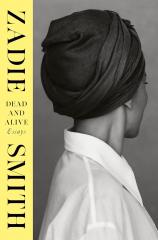Dead and Alive: Essays
Review
Dead and Alive: Essays
In a kind and welcoming foreword, Zadie Smith offers us options for reading DEAD AND ALIVE. Just head to page one, then onward. Choose subjects from the Table of Contents. Revisit an old essay and see how it has fared. No one was more grateful for this latitude than me. I was impressed by the depth and width of her topics, acquaintances, engagements and comments on our disconcerting days.
I began with “The Fall,” which was written for The New Yorker in November 2023 and is about Smith’s teenage years. Smith had been thinking about teenagers lately since she had one herself now. She watched teenage girls make choices between Barbie and Oppenheimer, and she compared the two films: brittle, impossible perfection on the one hand, apocalypse on the other. It recalled her girlhood memories that stretched between the two extremes.
"Many more people of all stripes and abilities meet up with Zadie Smith in DEAD AND ALIVE. She sees and embraces strength, artistry and decency, and I welcome her help in understanding our world."
The “fall” itself was the slipping/sliding/letting go from her bedroom windowsill and crashing 40 feet below into her Pakistani neighbor’s small yard. She was badly injured, on crutches for a long time, and felt faintly ridiculous. This feeling was all part of being a buck-toothed brown girl who fell out of her own home. (She also wore one red shoe, one white. She claimed to have seen movies she had not. She was 15.) Eventually she took this teenage misery back to her “foetid” armchair, and she questioned her admiration for Holden Caulfield and his eternal catching in the rye. She opened a book and retreated.
In another essay, “A Speech for the Kenyon Review,” given on November 8, 2024, Smith accepted the Award for Literary Achievement in third person. The speech itself was gracious and short. She devoted the remaining nine minutes (she had been given 10) to retelling Flannery O’Connor’s “The Life You Save May Be Your Own.” She analyzed Mr. Shiftlet, the villain, comparing his character to the president Americans had just voted into office. She connected good people who believe themselves decent to the mother, the elder Lucynell.
Finally, Smith explained the last group, the young Lucynells, as truly afflicted people who struggle and rely on others to fashion a tolerable world. Right now, it feels like the Mr. Shiftlets are ascendent, and we have abandoned the weakest among us. She encouraged us not to do that. She closed with a quotation from O’Connor herself: “[Y]ou have to cherish the world at the same time that you struggle to endure it.”
“Under the Banner of New York” was written in response to Halloween 2017 when a trucker drove down the West Side Highway and deliberately killed eight people. The essay is a tribute to both the predictable routines of life in cities and the people who come together in an emergency, work together to settle the situation, and, having other places to be, go on their way. Smith uses an example from her life when an elderly Chinese woman had fallen in her neighborhood, dropping her bags of accumulated trash. She had been part of an extremely diverse squad who put the lady back on her feet, checked her ankles, and chased down the tin cans and bottles. One found her hat, another retied her shoelaces, and then all vanished. The only thing the New Yorkers had in common was compassion. And then flight.
New Yorkers notice one another, perhaps even count on one another, but there are no dwelling-upon identities or “let’s get to know one another” sentiments. She uses and resonates with a line from Nick Laird’s poem, “New York Elasticity”: “something of this city’s brute capacity for gathering is like a shining in my head.” Smith rejoiced in that phrase and said that the New York she writes about is so elastic that it means nothing at all. The capacity to gather without precise definition is a form of freedom that cities understand and use.
Many more people of all stripes and abilities meet up with Zadie Smith in DEAD AND ALIVE. She sees and embraces strength, artistry and decency, and I welcome her help in understanding our world.
Reviewed by Jane T. Krebs on October 31, 2025
Dead and Alive: Essays
- Publication Date: October 28, 2025
- Genres: Essays, Nonfiction
- Hardcover: 352 pages
- Publisher: Penguin Press
- ISBN-10: 0593834682
- ISBN-13: 9780593834688




